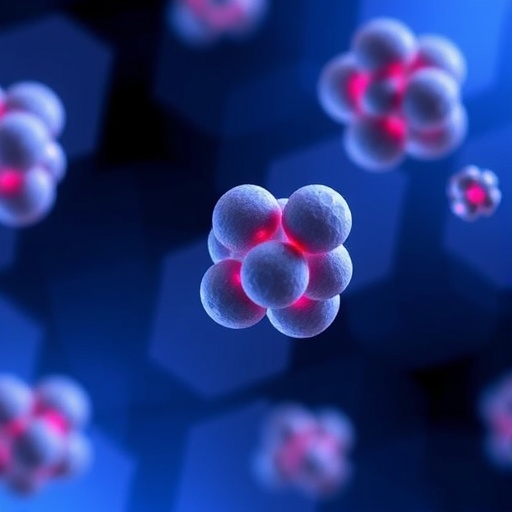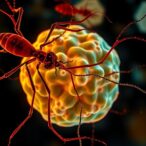In a groundbreaking study published in the scientific journal Scientific Reports, researchers have unveiled a novel method for the encapsulation of gallic acid using Balangu seed mucilage nanoparticles. This research, spearheaded by Rostamabadi and Shekarchizadeh, highlights the innovative use of ultrasonication combined with an antisolvent precipitation technique to fabricate these nanoparticles. The implications of these findings could revolutionize the field of drug delivery and nutraceutical applications, providing new avenues for enhancing the stability and bioavailability of various bioactive compounds.
The increasing interest in natural polysaccharides for drug delivery systems has opened up new research opportunities. Balangu seeds, rich in mucilage, present a promising option due to their biocompatibility and potential to improve the solubility of poorly water-soluble compounds like gallic acid. Gallic acid, a polyphenolic compound with numerous health benefits, is known for its antioxidant and anti-inflammatory properties. However, its therapeutic efficacy is often limited by its low solubility and rapid degradation. By encapsulating gallic acid within nanoparticles, researchers aim to enhance its delivery and prolong its action within the body.
The methodology employed in this study is particularly noteworthy. The ultrasonication-antisolvent method allows for the creation of nanoparticles at a molecular level, ensuring a uniform and controlled size distribution. This technique not only increases the efficiency of the encapsulation process but also enhances the stability of the nanoparticles, making them viable for various biomedical applications. The precise control offered by ultrasonication enables researchers to fine-tune the characteristics of the nanoparticles, including their size, morphology, and release profiles.
Throughout the experimental phase, the researchers meticulously examined the physicochemical properties of the fabricated nanoparticles. Techniques such as scanning electron microscopy and dynamic light scattering were utilized to assess the morphology and size distribution of the particles. The results demonstrated that the generated nanoparticles were spherical and had a size range suitable for optimal cellular uptake, which is crucial for effective drug delivery. These findings raise exciting possibilities for the use of Balangu seed mucilage nanoparticles in real-world applications, potentially paving the way for new formulations of dietary supplements and pharmaceuticals.
Moreover, the release kinetics of gallic acid from the nanoparticles were carefully evaluated. The study revealed that the encapsulated gallic acid exhibited a controlled release profile, which is a vital aspect in any drug delivery system. Controlled release mechanisms ensure that therapeutic agents are released over an extended period, maximizing their effectiveness while minimizing potential side effects. This feature of the nanoparticles makes them an attractive option for sustained therapeutic applications, thereby enhancing patient compliance and treatment outcomes.
The extensive characterization of Balangu seed mucilage nanoparticles also shed light on their interaction with biological media. Understanding how these nanoparticles behave in physiological conditions is critical for determining their potential in clinical applications. The researchers conducted stability and release studies in various simulated gastrointestinal media, and the findings indicated that the nanoparticles maintained their structural integrity, further supporting their prospect as effective carriers for oral drug delivery.
The biocompatibility of the nanoparticles is another critical factor that the researchers emphasized. Safety and toxicity assessments are essential steps in the development of any new drug delivery system. The study included cytotoxicity assays using human cell lines to evaluate the safety profile of the nanoparticles. The results demonstrated that the Balangu seed mucilage nanoparticles exhibited minimal cytotoxic effects, reinforcing their potential as a safe and effective delivery mechanism for bioactive compounds.
Beyond the immediate findings of this research, the broader implications are worth noting. The world is gradually shifting towards greener and more sustainable methods of production in pharmaceuticals and nutraceuticals. Utilizing natural polysaccharides derived from plants, such as Balangu seeds, aligns with this trend. It not only offers a renewable resource but also opens up opportunities for the development of eco-friendly drug delivery systems. The ability to create nanoparticles from natural materials could revolutionize manufacturing processes in the pharmaceutical industry, reducing reliance on synthetic polymers that often raise environmental concerns.
The study presented by Rostamabadi and Shekarchizadeh stands as a testament to the potential of harnessing nature’s resources for advanced biomedical applications. As researchers continue to explore the versatility of natural polymers, it is evident that the field is ripe for development. Future investigations may expand on the findings of this study by examining the encapsulation of other valuable compounds and the scalability of nanoparticle production methods.
In summary, the advent of Balangu seed mucilage nanoparticles represents a significant advancement in the field of drug delivery systems. Through innovative methodologies and comprehensive evaluations, the researchers have provided compelling evidence that supports the use of these nanoparticles for encapsulating gallic acid, thus enhancing its therapeutic potential. With continued research and development, this novel approach could lead to the creation of effective and sustainable delivery systems that align with the growing demand for natural products in healthcare.
As this research gains traction, it will likely encourage further studies into the applications of other natural polysaccharides in drug delivery systems. The integration of such green technologies in medicine not only promotes sustainability but also fosters innovations that could ultimately enhance healthcare outcomes around the globe. The future of drug delivery seems promising, with natural products taking center stage as both safe and effective alternatives to traditional methods.
The journey of Balangu seed mucilage nanoparticles from conception to practical application is just beginning. As the scientific community delves deeper into understanding these nanoparticles, the potential they hold for improving human health and well-being becomes increasingly evident. The next steps will involve clinical trials and real-world testing to validate their effectiveness and safety in diverse populations, showcasing the critical bridge between laboratory findings and practical solutions in medicine.
This transformative research not only exemplifies the ingenuity within the scientific community but also serves as an inspiration for future innovations. With each new finding, researchers are closer to developing solutions that not only solve immediate health challenges but also pave the way for a more sustainable and health-conscious future. The work of Rostamabadi and Shekarchizadeh is a pioneering endeavor that could set the precedent for a new era in drug delivery systems, putting natural products at the forefront of therapeutic advancements.
Subject of Research: Development of Balangu seed mucilage nanoparticles for encapsulation of gallic acid.
Article Title: Development of Balangu seed mucilage nanoparticles fabricated through ultrasonication-antisolvent method for encapsulation of gallic acid.
Article References:
Rostamabadi, M.M., Shekarchizadeh, H. Development of Balangu seed mucilage nanoparticles fabricated through ultrasonication-antisolvent method for encapsulation of gallic acid.
Sci Rep 15, 36922 (2025). https://doi.org/10.1038/s41598-025-20950-6
Image Credits: AI Generated
DOI:
Keywords: Balangu seed mucilage, nanoparticles, ultrasonication, gallic acid, drug delivery, biocompatibility, sustainable methods, natural polysaccharides.
Tags: antioxidant properties of gallic acidantisolvent precipitation techniqueBalangu seed mucilagebioavailability enhancementbiocompatible nanoparticlesdrug delivery systemsgallic acid encapsulationnatural polysaccharides in medicinenutraceutical applicationspolyphenolic compoundssolubility improvement of compoundsultrasonication nanoparticles


